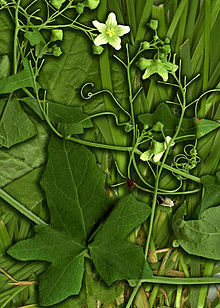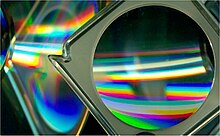
A camera lens is an optical lens or assembly of lenses used in conjunction with a camera body and mechanism to make images of objects either on photographic film or on other media capable of storing an image chemically or electronically.

Stereoscopy is a technique for creating or enhancing the illusion of depth in an image by means of stereopsis for binocular vision. The word stereoscopy derives from Greek στερεός (stereos) 'firm, solid', and σκοπέω (skopeō) 'to look, to see'. Any stereoscopic image is called a stereogram. Originally, stereogram referred to a pair of stereo images which could be viewed using a stereoscope.

Imaging is the representation or reproduction of an object's form; especially a visual representation.

An image scanner—often abbreviated to just scanner—is a device that optically scans images, printed text, handwriting or an object and converts it to a digital image. Commonly used in offices are variations of the desktop flatbed scanner where the document is placed on a glass window for scanning. Hand-held scanners, where the device is moved by hand, have evolved from text scanning "wands" to 3D scanners used for industrial design, reverse engineering, test and measurement, orthotics, gaming and other applications. Mechanically driven scanners that move the document are typically used for large-format documents, where a flatbed design would be impractical.
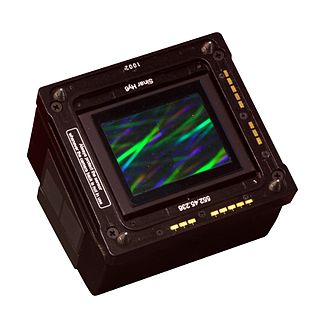
A digital camera back is a device that attaches to the back of a camera in place of the traditional negative film holder and contains an electronic image sensor. This lets cameras that were designed to use film take digital photographs. These camera backs are generally expensive by consumer standards and are primarily built to be attached on medium- and large-format cameras used by professional photographers.

A stereo camera is a type of camera with two or more lenses with a separate image sensor or film frame for each lens. This allows the camera to simulate human binocular vision, and therefore gives it the ability to capture three-dimensional images, a process known as stereo photography. Stereo cameras may be used for making stereoviews and 3D pictures for movies, or for range imaging. The distance between the lenses in a typical stereo camera is about the distance between one's eyes and is about 6.35 cm, though a longer base line produces more extreme 3-dimensionality.
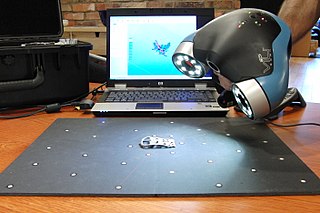
3D scanning is the process of analyzing a real-world object or environment to collect three dimensional data of its shape and possibly its appearance. The collected data can then be used to construct digital 3D models.
A planetary scanner is a type of image scanner for making scans of rare books and other easily damaged documents. In essence, such a scanner is a mounted camera taking photos of a well-lit environment. Originally, such scanners were expensive and could only be found in archives and museums, but with the availability of cheap, high-resolution digital cameras, DIY planetary scanners have become affordable, and for instance are being used by volunteer scan providers for Project Gutenberg.

Virtual cinematography is the set of cinematographic techniques performed in a computer graphics environment. It includes a wide variety of subjects like photographing real objects, often with stereo or multi-camera setup, for the purpose of recreating them as three-dimensional objects and algorithms for the automated creation of real and simulated camera angles. Virtual cinematography can be used to shoot scenes from otherwise impossible camera angles, create the photography of animated films, and manipulate the appearance of computer-generated effects.
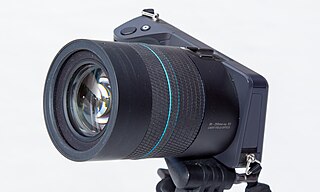
A light field camera, also known as a plenoptic camera, is a camera that captures information about the light field emanating from a scene; that is, the intensity of light in a scene, and also the precise direction that the light rays are traveling in space. This contrasts with conventional cameras, which record only light intensity at various wavelengths.

A motion picture film scanner is a device used in digital filmmaking to scan original film for storage as high-resolution digital intermediate files.
A structured-light 3D scanner is a 3D scanning device for measuring the three-dimensional shape of an object using projected light patterns and a camera system.

A digital microscope is a variation of a traditional optical microscope that uses optics and a digital camera to output an image to a monitor, sometimes by means of software running on a computer. A digital microscope often has its own in-built LED light source, and differs from an optical microscope in that there is no provision to observe the sample directly through an eyepiece. Since the image is focused on the digital circuit, the entire system is designed for the monitor image. The optics for the human eye are omitted.

A time-of-flight camera, also known as time-of-flight sensor, is a range imaging camera system for measuring distances between the camera and the subject for each point of the image based on time-of-flight, the round trip time of an artificial light signal, as provided by a laser or an LED. Laser-based time-of-flight cameras are part of a broader class of scannerless LIDAR, in which the entire scene is captured with each laser pulse, as opposed to point-by-point with a laser beam such as in scanning LIDAR systems. Time-of-flight camera products for civil applications began to emerge around 2000, as the semiconductor processes allowed the production of components fast enough for such devices. The systems cover ranges of a few centimeters up to several kilometers.

The Fujifilm FinePix Real 3D W series is a line of consumer-grade digital cameras designed to capture stereoscopic images that recreate the perception of 3D depth, having both still and video formats while retaining standard 2D still image and video modes. The cameras feature a pair of lenses, and an autostereoscopic display which directs pixels of the two offset images to the user's left and right eyes simultaneously. Methods are included for extending or contracting the stereoscopic baseline, albeit with an asynchronous timer or manually depressing the shutter twice. The dual-lens architecture also enables novel modes such as simultaneous near and far zoom capture of a 2D image. The remainder of the camera is similar to other compact digital cameras.
An office camera is a digital camera device that performs tasks in offices such as document scanning, physical object imaging, video presentation and web conferencing. It is similar to the document camera, which is normally used on podiums in classrooms and meeting rooms for presentations.
2D to 3D video conversion is the process of transforming 2D ("flat") film to 3D form, which in almost all cases is stereo, so it is the process of creating imagery for each eye from one 2D image.
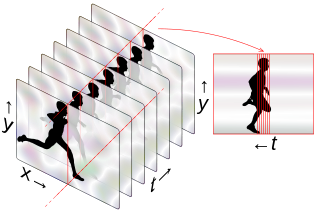
Strip photography, or slit photography, is a photographic technique of capturing a two-dimensional image as a sequence of one-dimensional images over time, in contrast to a normal photo which is a single two-dimensional image at one point in time. A moving scene is recorded, over a period of time, using a camera that observes a narrow strip rather than the full field. If the subject is moving through this observed strip at constant speed, they will appear in the finished photo as a visible object. Stationary objects, like the background, will be the same the whole way across the photo and appear as stripes along the time axis; see examples on this page.
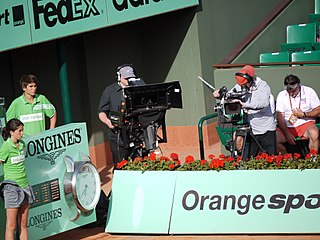
Stereo photography techniques are methods to produce stereoscopic images, videos and films. This is done with a variety of equipment including special built stereo cameras, single cameras with or without special attachments, and paired cameras. This involves traditional film cameras as well as, tape and modern digital cameras. A number of specialized techniques are employed to produce different kinds of stereo images.
Cultural property imaging is a necessary part of long term preservation of cultural heritage. While the physical conditions of objects will change over time, imaging serves as a way to document and represent heritage in a moment in time of the life of the item. Different methods of imaging produce results that are applicable in various circumstances. Not every method is appropriate for every object, and not every object needs to be imaged by multiple methods. In addition to preservation and conservation-related concerns, imaging can also serve to enhance research and study of cultural heritage.
